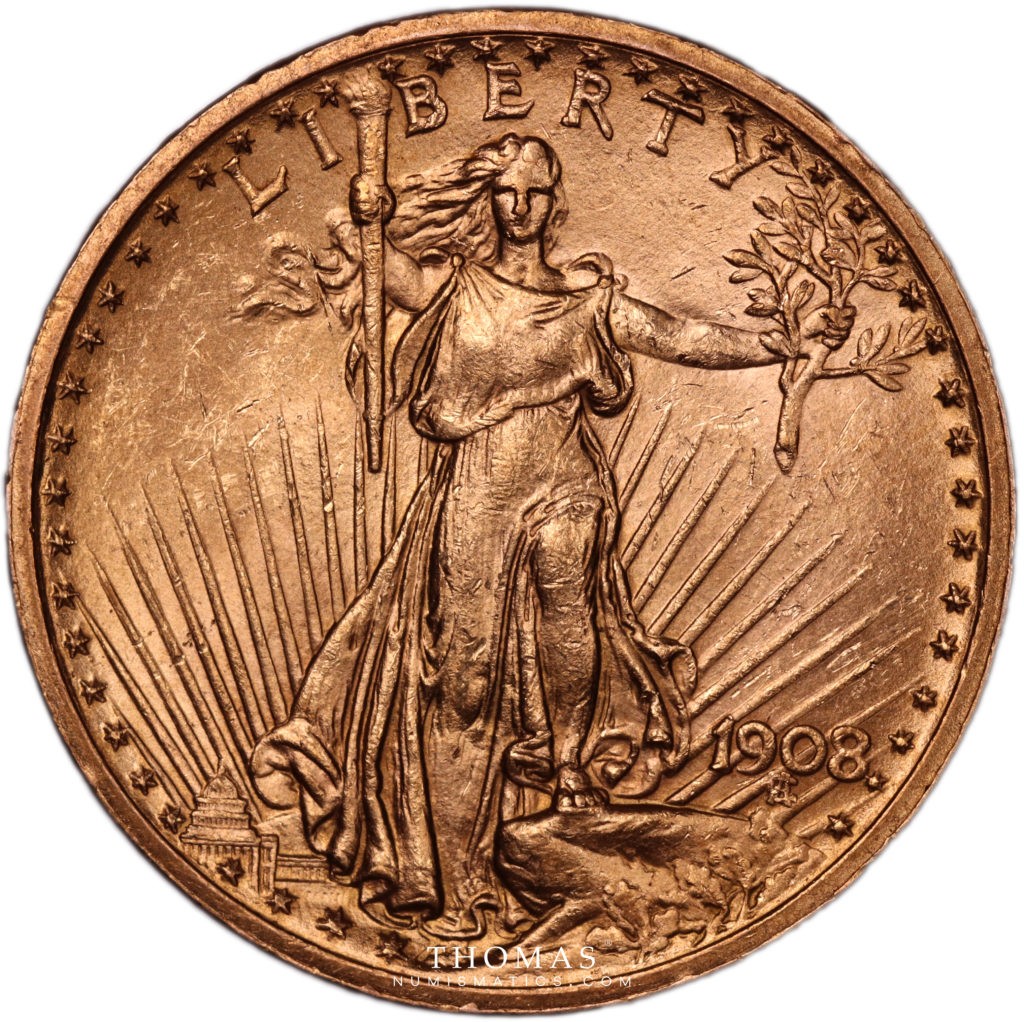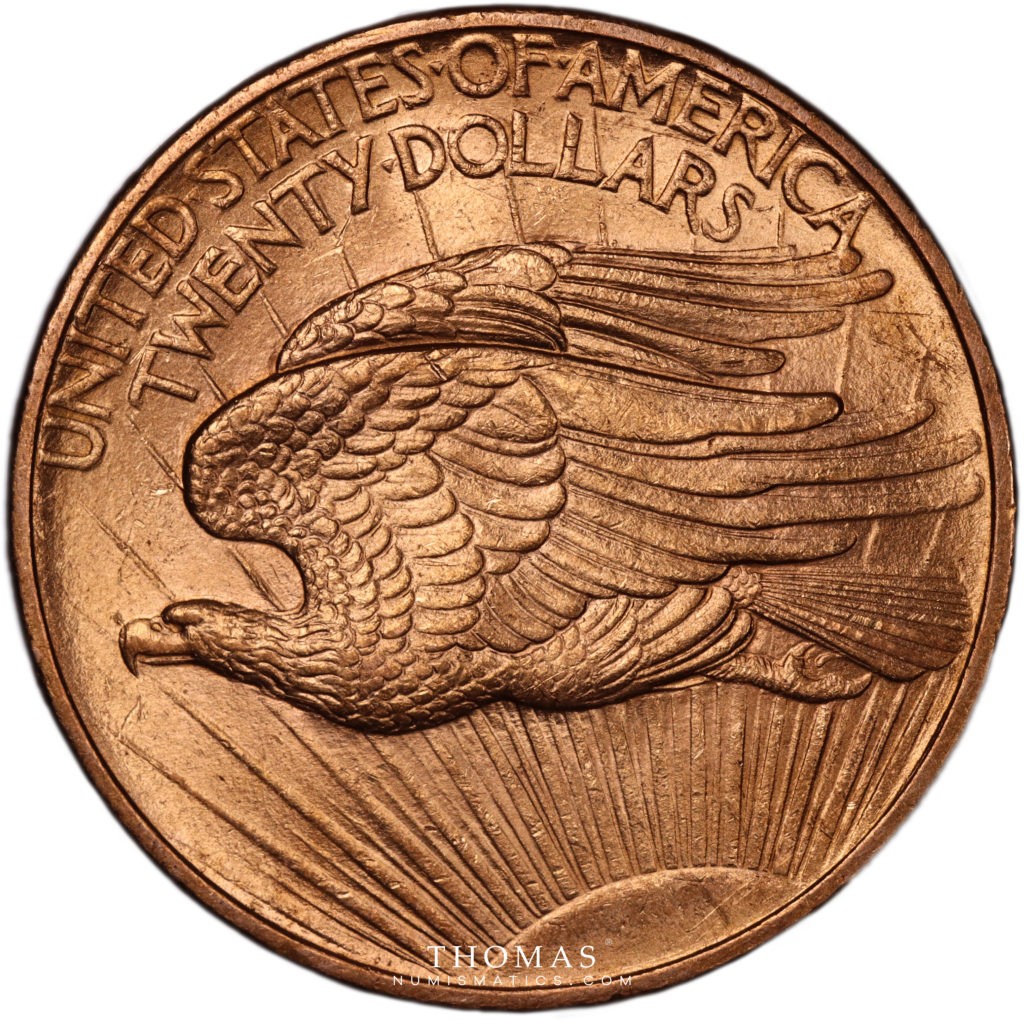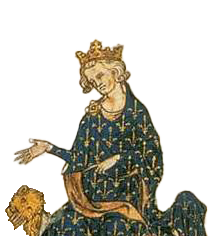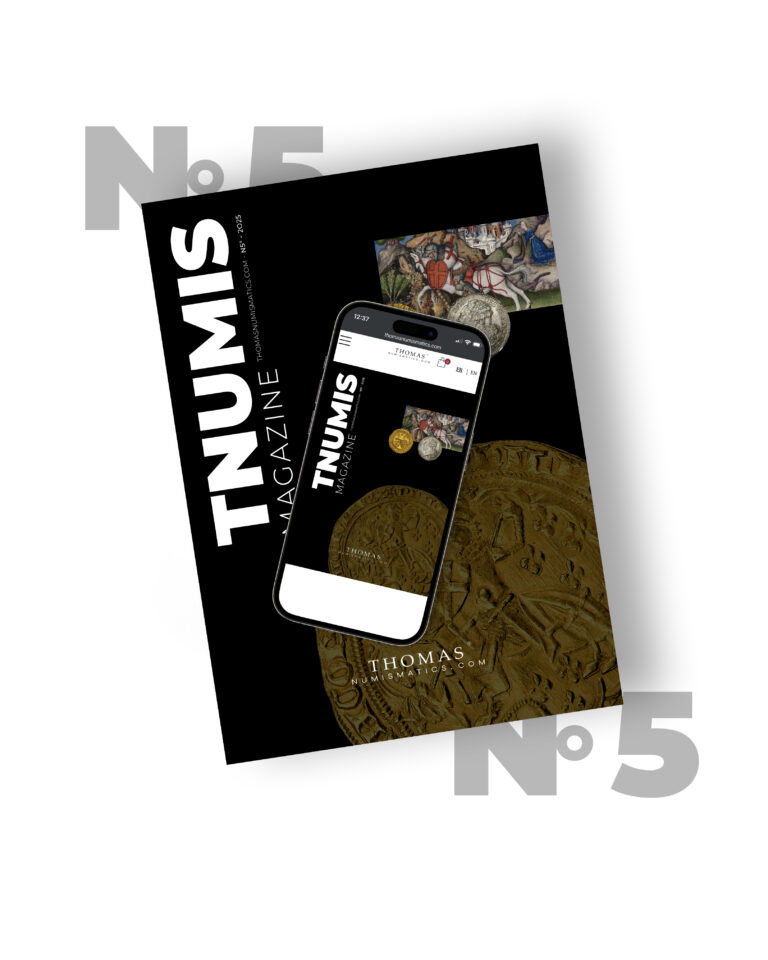
Discover all the news and articles from TNUMIS Magazine exclusively
American 20 dollar gold coin
The 20 dollar coins are among the most famous American gold coins. There are two types: the Longacre and the Saint-Gaudens 20 dollars. Struck between 1849 and 1933, these coins are emblematic of American numismatics, while being a reliable investment, especially in times of crisis.
History of the 20 dollar coin
The 20 dollar gold coin is an important currency in the history of the United States. Its production began at the time of the gold rush, when numerous metal deposits were discovered in California in 1848.
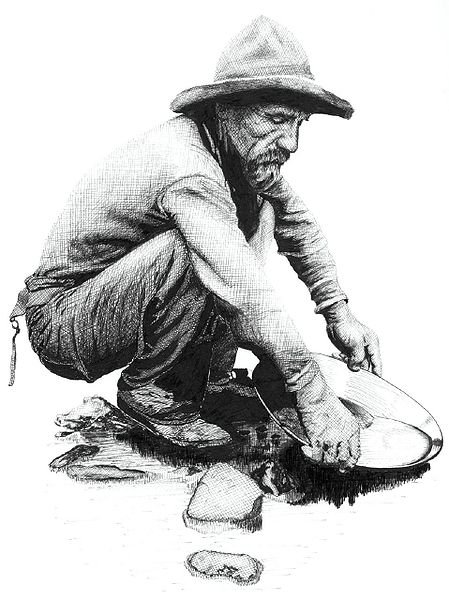
The government immediately took advantage of this and decided to create a new 20 dollar gold coin. The influx of gold from California dramatically changed the world market for the metal. The value of silver surpassed that of gold and it became more attractive to melt silver coins into bullion. Silver coins quickly disappeared and were replaced by 20 dollar gold coins. The quantities of gold were so large that it was easier and faster to create a large 20 dollar coin rather than smaller 5 or 10 dollar coins.
The Great Depression in 1933 brought an end to the production of the 20 dollar gold coin and all American gold coins.
In total, approximately 175 million Liberty 20 dollar gold coins were put into circulation with a face value of 3.5 billion dollars.
Nicknames and features of the 20 dollar gold coin
A Liberty dollar
Twenty dollar coins are also referred to as Liberty Head because the obverse of the coins depicts a portrait of Liberty.
Between colonization and 1792, the United States used mostly foreign currencies for trade. Due to the lack of English currency, the coins used were escudos, Spanish pistols, Portuguese reis and French gold Louis, from neighboring colonies. In 1792, the law established the rules for a local currency: it had to bear an allegory of liberty on the obverse with the year of minting, and an eagle on the reverse. Gold coins of 5 and 10 dollars were then struck from 1795.
The 20 dollar coin retains these two national emblems: the allegory of liberty and the eagle.
A Double Eagle
The 20 dollar coin also has a second nickname: Double Eagle. This is to distinguish it from the traditional American “Eagle”: the reference 10 dollar gold coin called Eagle, because of the eagle design struck on its reverse. The 20 dollar coin was then logically called its double.
The characteristics of the 20 dollars
The coins are made of 90% gold and 10% copper alloys. Indeed, gold is very malleable and must be reinforced by a harder metal to resist the constraints of the circulation of coins.
They weigh 33.436 grams for a title of 900/1000e, they contain 0.967 ounces of pure gold. This is the largest American gold coin intended for current circulation that has been minted in the United States.
Although the 20 dollar coin was minted from 1849 to 1933, there are two versions:
- the 20 dollar Longacre coin, minted from 1849 to 1907,
- the 20 dollar Saint-Gaudens coin, minted from 1907 to 1933.
The 20 dollar gold Liberty coin of Longacre
The Longacre 20 dollar coin was the first American 20 dollar gold coin. The U.S. Congress authorized its minting in February 1849, following the beginning of the gold rush.
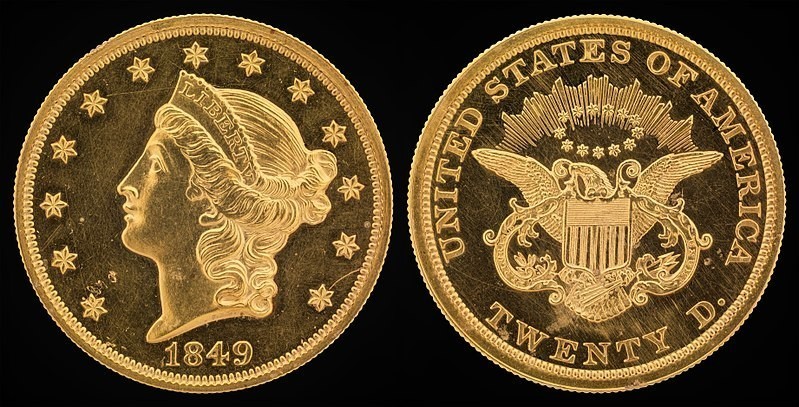
These coins were designed by the sculptor James Barton Longacre. He was the first engraver to put his initials on American coins.
In 1849, proofs were struck by the United States Mint and the first coins were actually put into circulation in 1850. A proof is now kept in the Smithsonian Institution’s museum and research center in Washington.
The 20 Liberty Head dollars were then produced in five different mints: Philadelphia, Carson City (CC), Denver (D), New Orleans (O) and San Francisco (S). The mint mark is visible on the reverse under the eagle. Only the coins minted in Philadelphia do not bear a letter.
On the obverse, the head of Liberty is surrounded by thirteen stars. The inscription “Liberty” sits on a band below the year of mintage. On the reverse, an eagle is depicted with its wings spread. It holds an olive branch (peace) on the right and a bundle of thirteen arrows (war) on the left. From its beak is a ribbon with the following motto: “E pluribus unum”, which could be translated as “unity is strength”. Above the bird’s head, thirteen stars are surmounted by sunbeams. These are the thirteen independent colonies of England since 1776.
The inscription “In God We Trust” appears only on coins minted from 1866. In addition, we note the engraving of the facial favor and “United States of America”.
The production of this first 20 dollar gold coin stopped in 1907, when the President of the United States, Theodore Roosevelt, decided to renew the American gold coins.
The 20 dollar Saint-Gaudens coin
Theodore Roosevelt was more interested in the appearance of national currencies than most of his predecessors. As an avid admirer of ancient Greek coins, he decided to modify the American gold coins in this sense. The sculptor Augustus Saint-Gaudens was appointed to design a new 20 dollar coin.
Liberty’s posture was changed from a profile to standing and walking. Above her head, the word “Liberty” is still inscribed. She walks straight ahead against a background of a rising sun, with the Capitol in the background. Dressed in a floating peplos, she holds a torch in her right hand and an olive branch in her left. The edge of the coin is surrounded by 46 five-pointed stars.
On the reverse, the eagle is also evolving. It flies in the rays of the sun. On the upper part, there are two inscriptions on two lines, “United States of America” and “twenty Dollars”.
Following the crisis of 1929, President Franklin Roosevelt took drastic measures to limit the hoarding of gold by individuals: the gold of Americans was requisitioned. In 1933, the minting of gold coins was stopped and Franklin Roosevelt ordered the withdrawal of all coins from circulation. An estimated 445,500 1933 Double Eagles were melted down. Subsequently, some very rare 1933 Double Eagles reappeared. They are considered to be among the most prestigious American coins.
Rating of the twenty dollar gold coin
Henceforth, the 20 dollar Liberty coins are coins with a significant premium differential. As a reminder, this numismatic term means that the background premium, i.e. the premium observed in normal times and the premium observed in times of crisis are clearly different.
Indeed, 20 dollar gold coins are very popular in the world, especially among Americans for whom it is a safe haven when everything collapses.
Their value follows the evolution of the gold price and is coupled with an interesting numismatic value. These coins, which were initially worth 20 dollars, are now trading for at least 1,500 dollars, which is 100 times their initial face value.
As you can see, the reason Liberty Head 20 dollar coins are so highly regarded is because they are both bullion and collector gold coins.
If you want to invest and collect 20 gold Liberty dollars, check out our shop.
Sources :
Voone actu
L’or et l’argent
Sacra Moneta
Au Coffre
